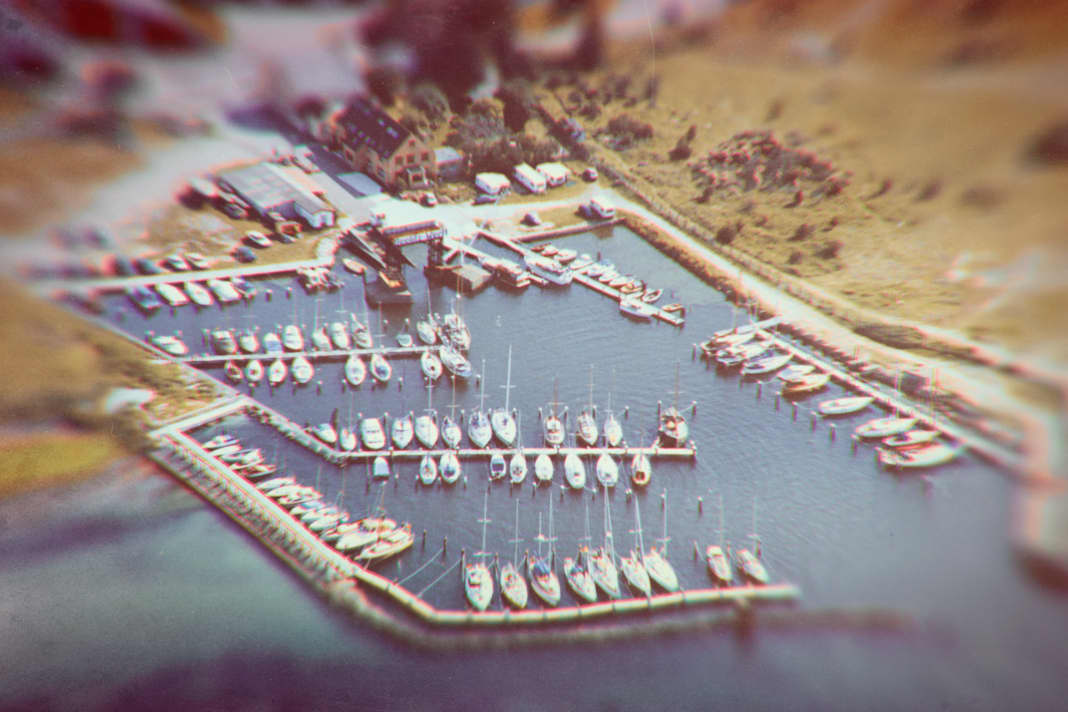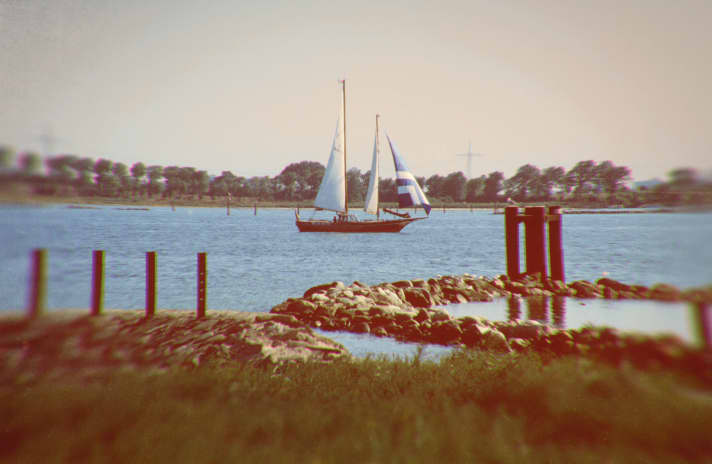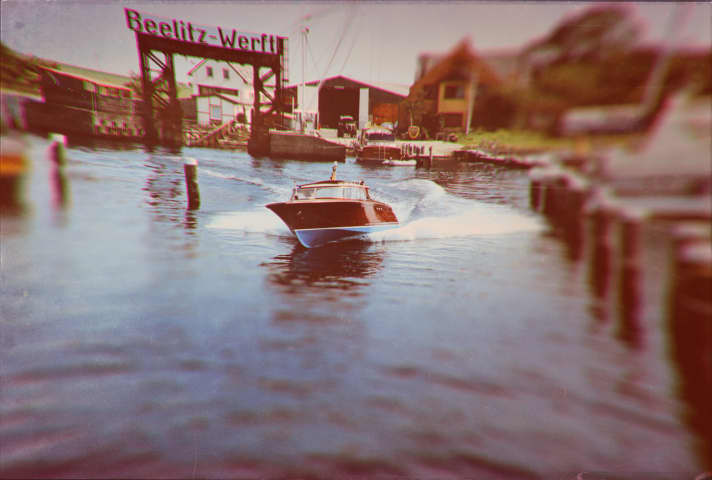





- The Beelitz shipyard at the foot of the Fehmarnsund Bridge
- In 1958, Beelitz moved completely to West Berlin
- The former ferry harbour at Fehmarnsund has become the new home of Beelitz
- Wood was the material of choice at Beelitz
- Beelitz built good-natured boats for safe cruising
- Innovation and tradition
- Beelitz outboards restored as a hobby
- The timber construction tradition on Fehmarn is preserved
Wooden boats are fascinating. Glossy varnished surfaces and immaculate teak decks are not only pleasing to the eye, they also feel beautiful and embody both traditional boatbuilding and classic yachting in an inimitable way. Both were closely associated in Germany with such illustrious names as Max Oertz, Henry Rasmussen and Ernst Burmester, whose yachts became famous on the international stage at an early stage.
However, it would be impossible to describe the era of yachts that are now revered as classics without mentioning numerous names of designers who are now only known to initiated enthusiasts, because their work was not dedicated to long-lasting success in regattas. In Germany after the Second World War, for example, these were men such as Anton Miglitsch and Kurt Oehlmann, whose drawing boards provided cruising sailors with seaworthy, solid sea cruisers, most of which are still in use today.
The Beelitz shipyard at the foot of the Fehmarnsund Bridge
The same applies to the shipyards where these boats were built. These were often family-run businesses that are hardly known today, where the best craftsmanship was emphasised for generations. This includes the former Beelitz shipyard on Fehmarn at the foot of the bridge over the Fehmarn Sound. It looks back on a history whose roots go back 140 years. Since then, three generations of the Beelitz family have helped to shape the local construction of wooden sailing and motor yachts.
It all began in imperial Berlin. It was here that Robert Beelitz I founded a boat hire company for rowing boats and canoes in Zehlendorf on the Großer Wannsee in 1883. From then on, he also took care of all the necessary maintenance work for his fleet and eventually offered boat repairs for external customers when there was free capacity. His son, Robert Beelitz II, learnt the boatbuilding trade in Potsdam and, after successfully passing his master craftsman's examination in 1928, founded a shipyard there in Leipziger Straße. From then on, he built everything that was in demand on the waters of Berlin: canoes, dinghies and keelboats.
After a fire at the shipyard in 1943, it was rebuilt on the same site. However, as there was no room for expansion on the site, the business was relocated to Alt Töplitz in Potsdam, directly on the Kleiner Zernsee, which is part of the Havel. Not far from today's motorway bridge, fishing boats, dinghies, paddle boats, dinghy cruisers and motorboats were built from wood. Beelitz built according to his own designs or according to designs by well-known designers of the time such as Karl Martens and Artur Tiller, who was known as an independent designer in Berlin for his national cruisers as well as the "car boats" that were popular at the time.
In 1958, Beelitz moved completely to West Berlin
Robert Beelitz III learnt the craft of boatbuilding from his father in 1948, passed his journeyman's examination in 1951 and his master craftsman's examination in 1955. A year earlier, his father Robert Beelitz II had decided to establish a second shipyard site on a leased plot of land on the Großer Wannsee in Zehlendorf in West Berlin.
Due to the difficult political and economic conditions in the GDR, the location in Alt Töplitz was then completely abandoned in 1958 and operations were moved entirely to West Berlin at Großer Wannsee.
Motorboats with such illustrious names as "Loreley", a 6.70 metre long forecastle, and the larger models "Havel", "Berolina" and "Aspasia" were built. These forecastle boats were characterised by the curved shape of the windows in the hull, which was intended to lighten the rather massive shape of the foredeck.
The forward cabin cruisers with the type designations "Helgoland", "Köln" or "Extra dry" began with dimensions of 6.0 metres in length and 1.80 metres in width, were made of marine plywood in a seamless frame construction and for the first time featured a round plexiglass glazing at the front, reminiscent of large limousines from the automotive industry. The cabin was designed as a pulpit cabin and offered a comfortable way to take a trip even in the rain. Numerous boats of this design still ply the Havel in Berlin and the numerous lakes in Brandenburg today.
Racing boats and express limousines
At this time, racing boats were also being built in Berlin-Wannsee. And father and son Robert Beelitz II and III enthusiastically took part in these motorboat races as drivers themselves.
The highly sought-after express limousines were also developed in these years. These were fast motorboats with an open steering position in front of a cabin, reminiscent of the water taxis in Venice. They were built with the names of maritime cities in three sizes: "Travemünde" (6.50 m x 2.25 m), "Timmendorf" (7.20 m x 2.35 m) and "Westerland" (8.00 m x 2.45 m).
Although these post-war motorboats were equipped with good engine power, they were always intended for spending time on the water. In addition to a toilet and cooking facilities, comfortable berths were part of the standard equipment. A sufficiently large cockpit provided space for socialising.
The former ferry harbour at Fehmarnsund has become the new home of Beelitz
In 1967, Robert Beelitz II relocated his boatbuilding activities to the Baltic Sea island of Fehmarn. There he acquired the former ferry harbour of Fehmarnsund, which had become obsolete after the bridge was built in 1963. Robert Beelitz II converted it into a marina and set up his shipyard on the land side.
Beelitz sat at the living room window with binoculars and gave advice on good seamanship
As a strong personality and old-school entrepreneur, he managed the shipyard and marina with an eye for detail right into old age. He was not afraid to give his berth holders tips on good mooring manoeuvres when he observed seamanship in need of improvement from the window of his living room - binoculars were always available on the windowsill.
His son Robert Beelitz III continued to run the shipyard in Berlin as a second location until 1975. As the lease for the site was not extended by the state of Berlin and no alternative site with water access could be found in the then cramped West Berlin, he also moved to Fehmarn and from then on ran the shipyard and harbour there together with his father. The second and last Berlin location of the Beelitz shipyard on the Großer Wannsee is now the starting point for steamboat trips on the Havel and the Brandenburg waters.
Strong current, but good location between Lübeck and Kiel
After the conversion, the shipyard harbour on Fehmarn offered space for around 115 boats with a draught of up to 2.80 metres. The Beelitz shipyard once again produced new boats and was able to offer repairs and winter storage in two halls. An in-house metalworking shop worked on new builds and repairs. An extensive stock of parts was also available to the owners for their own work.
However, operating the marina turned out to be more complicated than expected. Caused by the strong currents in the Fehmarnsund (up to four knots), the harbour entrance was frequently in danger of silting up. Regular dredging work was necessary.
The harbour's location on the Fehmarn Sound as a link between the Bay of Lübeck and the Bay of Kiel, on the other hand, proved to be ideal for cruising sailors who wanted to visit the island of Fehmarn on their trips from one of these areas to the other.
Wood was the material of choice at Beelitz
Robert Beelitz III was a thoroughbred craftsman and a quiet constructor. When working on every boat and every workpiece, his love of wood as a material was just as evident as his solid craftsmanship. He never considered building plastic boats. If only to protect his employees, with whom he sometimes had an almost familial relationship, from toxic chemicals and vapours, as he always emphasised.
The shipyard, the harbour, working with wood as a material, but also the intensive contact with his customers and his employees were Robert Beelitz III's concern and purpose in life. He designed and manufactured wooden sailing and motor yachts, both as individual constructions and in small series. In 1983, Beelitz built a wooden motor yacht 11.75 metres long, powered by two Volvo Penta diesel engines, for a future owner from Berlin.
Ships were built that were widely known on the Baltic Sea, such as the 16-metre-long schooner "Flying Cloud", built in 1973 with a sail area of 100 square metres on the wind, which was considered the shipyard's flagship and often served as the start and finish ship at regattas in the area. Large mahogany motor yachts were launched, as well as numerous sailing yachts and motor sailers in series. These were natural varnished mahogany yachts with a deckhouse, carvel planking on glue joints and oak frames with a length of 10.75 metres, a width of 3.30 metres and a displacement of 7.5 tonnes. These yachts made the shipyard known to a large clientele. This was because these ships offered their crews a high level of comfort and protection in the weather conditions that usually prevailed on the North and Baltic Seas.

Beelitz built good-natured boats for safe cruising
Sailing yachts from Beelitz were mostly traditional long keelers, known for their good-natured sea behaviour and high course stability. They were almost always fitted with a teak deck. This was not only an aesthetic pleasure, but also extremely practical, as it offered great slip resistance when working on deck. A high ballast ratio ensured stability and safety in strong winds and rough seas. The motor sailers had both a steering position with wheel steering inside and tiller steering in the cockpit. The hull of the motorboats was made of mahogany, larch or marine plywood.
Each boat bore witness to Robert Beelitz's great love for the craft of boatbuilding.
The Beelitz shipyard became famous for its exceptionally high-quality paintwork. Each boat bore witness to Robert Beelitz's great love for the craft of boatbuilding. All boats were designed for quality, safety, durability and comfort and were used by their owners for many years with great satisfaction. After launching, the newbuilds were often moored in the shipyard's own harbour on Fehmarnsund and remained there for a long time.
When Robert Beelitz was designing, his focus was on safe cruising - even in adverse conditions. His boats were not intended for regattas with high speeds, large sail loads and fast tacking.
Innovation and tradition
The fact that the Beelitz shipyard not only stood for tradition in wooden boat building, but also for innovation, was demonstrated by the forecastle deckers that could be equipped with a combination of diesel engine and electric drive as early as 1996. A Volvo Penta MD 2040 with three cylinders and 40 hp with shaft and reversing gear installed amidships and an electric motor with Z-drive, which was powered by six 12-volt batteries with a capacity of 100 ampere-hours each, propelled the eight-metre-long boats swiftly forward.
Although the activities of the Beelitz shipyard increasingly focussed on repair work on and restoration of wooden boats, the "Princess i", an unusual new wooden motorboat, was also built in 2002 in response to a special customer request. This was a semi-open sports boat with a length of 8.87 metres, a width of 2.50 metres and a draught of 0.65 metres with a weight of 2,150 kilograms. The underwater hull was made of 12-millimetre marine plywood with an epoxy coating. The hull was double-diagonal carvel planked. It was powered by a 212 hp Steyr 236 built-in diesel with reversing gear. However, motorboats and sailing boats for smaller budgets were also still being launched at Fehmarnsund at this time.
Almost on the side, Robert Beelitz III designed and manufactured boats for his own leisure needs, such as his open motorboat "Königin" in moulded mahogany with a teak pole deck. This boat had a length of 5.50 metres, was 1.85 metres wide and was the new edition as well as a homage to a boat of the same name with a length of 6.50 metres and a 6 hp engine, built by his father in the 1930s.
A queen driven by a king
Naturally, only an outboard motor from König could be used for propulsion. A hull with an upturned bow section and flat stern allowed a relatively high speed even with small outboards of 20 to 60 hp. What a great way to maintain tradition, a queen powered by a king.
Robert Beelitz III also built a sailing dinghy for private leisure activities. Ice sailers made of boatbuilding plywood with a sail area of eight square metres were built for personal use in winter and for sale.
Despite everything, the third Beelitz found time to pursue his two great extra-professional passions: the restoration of historic outboards and ice sailing with sledges he designed himself.
Beelitz outboards restored as a hobby
His love of outboards began in 1985, and over the years he restored around 40 of these engines, all of which were fully functional and could be started personally by Robert Beelitz III on rare occasions. The manufacturers of the outboards and their products had illustrious names such as Laros, Effzett, Archimedes, König and Penta. The jewel in his collection was a Laros outboard motor from the 1950s. The 60 hp engine had brought him and his father success in Berlin motorboat races in the fifties and early sixties.
At the time, they had a friendship with the well-known König family. Father Rudolf König had founded a company for the construction of outboard motors in Berlin-Kreuzberg in 1927, and son Dieter had raced very successfully for many years with the company's own drives. König outboards won three German championships and four European championships. A memorial to Dieter König, who died in a crash with an ultralight aircraft, can be found in the harbour of the Motor-Rennboot-Club Berlin. Robert Beelitz III was in active dialogue with like-minded collectors of spare parts beyond the borders of Germany.

In 1982, Robert Beelitz II died. His son continued to run the business alone, and in its issue of 31 August 1983, the "Fehmarnsche Tageblatt" was able to report on the celebration of the 100th anniversary of the Beelitz shipyard. The islanders as well as owners of Beelitz boats and berth holders took a lively interest. In the same year, the fourth Beelitz was born with his grandson, who was christened Robert.
The timber construction tradition on Fehmarn is preserved
In 2007, Robert Beelitz III sold his shipyard on Fehmarnsund for health reasons to the boat builder Josef Martin, who already ran a renowned wooden boatyard on Lake Constance. This preserved the tradition of wooden boat building on the island of Fehmarn. And since the shipyard was sold again to Philipp Schaich, traditional boatbuilding has continued at this location.
Robert Beelitz III died in January 2008 at the age of 75. He found his final resting place on the island of Fehmarn. The 125-year-old family tradition of classic boatbuilding thus came to an end. After his death, the collection of restored outboards from Robert Beelitz III was donated by the Beelitz family to the German Maritime Museum in Bremerhaven in May 2008.
However, Beelitz boats are still a household name in the yachting scene. They can still be seen today on inland lakes, especially in Berlin and Brandenburg, as well as on the coasts of the North and Baltic Seas. The name Beelitz is also still to be found on the used yacht exchanges for motorboats and sailing yachts, which continue to find enthusiasts among connoisseurs.
Text: Helmut Kunze

